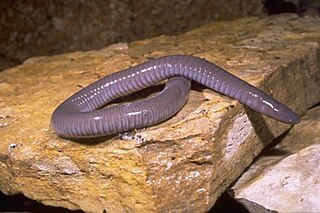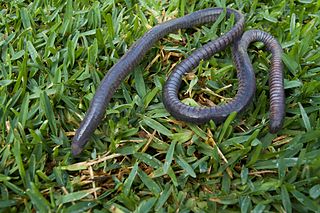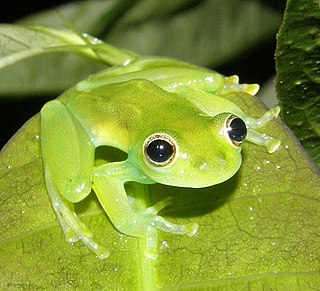
Incilius melanochlorus, formerly Bufo melanochlorus, is a mid-sized species of toad with a crested head in the family Bufonidae. It is primarily distinguished by its very long first finger with respect to the other fingers. It is found in southern Nicaragua, in the northern Cordillera Central and on the Atlantic slopes of eastern Costa Rica, and in western Panama.
Dermophis costaricense is a species of caecilian in the family Dermophiidae. It is endemic to Costa Rica and is found on the Atlantic versant of Cordillera de Tilarán, Cordillera Central, and Cordillera de Talamanca. Its taxonomic status is in need of a review.

Dermophis is a genus of worm-like amphibians in the family Dermophiidae, the Neotropical and Tropical African caecilians. They are found in the Middle America between southern Mexico and northwestern Colombia. Common names Mexican caecilians or Neotropical caecilians are sometimes used for them.
Dermophis glandulosus is a species of caecilian in the family Dermophiidae. It is found in northwestern Colombia, Costa Rica, and Panama. It is the southernmost species among Dermophis.

Dermophis mexicanus, also known commonly as the Mexican burrowing caecilian and the Mexican caecilian, is a species of limbless amphibian in the family Dermophiidae. The species is native to Mexico and Central America, where it burrows under leaf litter and plant debris.
Dermophis oaxacae, also known Oaxacan caecilian, is a species of caecilian in the family Dermophiidae. It is endemic to southwestern Mexico and occurs on the Pacific slopes and the Balsas depression in the states of Jalisco, Michoacán, Guerrero, Oaxaca, and Chiapas.
Dermophis occidentalis is a species of caecilian in the family Dermophiidae. It is endemic to south-western Costa Rica and occurs in the Pacific lowlands and premontane slopes, extending to the western part of the central valley. Its taxonomic status is unclear.

Dermophis parviceps is a species of caecilian in the family Dermophiidae. It is found in Costa Rica and Panama, and possibly in Colombia, depending on the source. Common names slender caecilian and La Loma caecilian have been coined for it.

Herpele squalostoma is a species of caecilian in the family Herpelidae. It is also known by the common name Congo caecilian. It is found in Central and extreme easternmost West Africa.

Oscaecilia is a genus of caecilians in the family Caeciliidae. The genus is distributed in southeastern Central America and northern South America, possibly extending into southern Brazil. They are sometimes known as the South American caecilians.
Oscaecilia osae is a species of caecilian in the family Caeciliidae. It is endemic to Costa Rica and is only known from the Golfo Dulce area, on the Pacific Ocean side of Costa Rica. The specific name osae refers to its type locality, the airstrip at La Sirena, being located on the Osa Peninsula. It is also known as the airstrip caecilia or airstrip caecilian.

Schistometopum thomense is a species of amphibian in the family Dermophiidae, endemic to São Tomé and Ilhéu das Rolas. It is found in most soils on São Tomé, from tropical moist lowland forests to coastal coconut plantations. It is absent only from the driest northern areas of the island. It is typically around 30 cm (12 in) in length, and is often bright yellow. The size of S. thomense can vary throughout São Tomé, however, and it is the only known caecilian to follow Bergmann's rule, which states that a decreasing temperature due to factors such as increasing altitude will cause an increase in the body size of endothermic vertebrate species. The island of São Tomé is a massive shield volcano, and it therefore has differing altitudes throughout the island, potentially resulting in the size diversity of S. thomense. This species may be referred to as the São Tomé caecilian, as the Agua Ize caecilian, or as the island caecilian, or by the local name of cobra bobo.

Sachatamia ilex is a species of frog in the family Centrolenidae. It is found in eastern Nicaragua, Costa Rica, Panama, western Colombia, and western Ecuador. Common name Limon giant glass frog has been coined for this species, apparently in reference to its type locality in the canton of Limón, Costa Rica, and it is also known as the ghost glass frog.

Teratohyla spinosa is a species of frog in the family Centrolenidae. It is found in the Pacific lowlands of northern and central Ecuador and western Colombia, northward on the Pacific slopes Panama and Costa Rica, as well as on the Caribbean slopes of Costa Rica, Nicaragua, and Honduras.

Dendropsophus phlebodes, the San Carlos treefrog or San Carlos dwarf treefrog, is a species of frog in the family Hylidae. It is found in western Colombia, Costa Rica, Nicaragua and Panama. Its natural habitats are tropical moist lowland forests, but it may also occur in disturbed habitats. It is threatened by habitat loss.
Isthmohyla debilis is a rare species of frog in the family Hylidae. It occurs in the Atlantic slopes of the Cordillera Central and Cordillera Talamanca in Costa Rica and western Panama as well as on the Pacific slopes in southwestern Panama. Common name Isla Bonita treefrog has been suggested for it.
Craugastor catalinae is a species of frogs in the family Craugastoridae. It is found in the Río Cotón drainage in the Pacific southwestern Costa Rica and on the Pacific slopes of Volcán Barú, western Panama. The specific name catalinae, rather obliquely, honors Karen R. Lips: Spanish name "Catalina" corresponds to Danish name "Karen". Lips collected a part of the type series and has "contributed substantially to our knowledge of the Río Cotón drainage herpetofauna and the declining amphibian populations problem in lower Central America."

Oedipina cyclocauda, commonly known as the Costa Rica worm salamander, is a species of salamander in the family Plethodontidae. It is found on the Caribbean slopes of northwestern Panama, eastern Costa Rica, Nicaragua, and northern Honduras. The specific name cyclocauda refers to the circular caudal grooves.

The barred hawk is a species of bird of prey in the family Accipitridae. It has also been known as the black-chested hawk.

The Dermophiidae are a family of common caecilians. They are found in Central and South America, and Africa. Like other caecilians, they superficially resemble worms or snakes.











